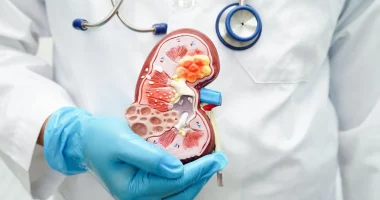The aorta is a big artery that transports blood from the heart to the body. Sometimes, the walls of the aorta can weaken and bulge out. When this happens in the belly area, it is known as an abdominal aortic aneurysm (AAA).
AAA might not show any symptoms and might not need treatment. But sometimes, treatment is needed to prevent serious problems.
This article explains what AAA is and how it can be treated.
Definition
An aneurysm happens when a weak spot forms in the wall of an aorta. The pressure inside the aorta can push against this weak spot, making it bulge out. This bulging is called an aneurysm.
An abdominal aortic aneurysm (AAA) is a swell that forms in the main artery called the aorta. The aorta carries blood from the heart to the remaining parts of the body. It goes down through the belly, giving blood to organs like the kidneys and liver. Then it splits into two, sending blood to the legs. AAA happens in the part of the artery just before it splits.
Several aneurysms don’t cause any problems. But others can burst, causing serious internal bleeding that can be deadly very quickly.
Types
Doctors categorize AAAs as small, medium, or large to help decide on treatment.
Small AAAs are 3–4.4 cm wide. They usually don’t burst and may not need treatment. Doctors suggest lifestyle modifications to prevent them from developing.
Medium AAAs are 4.5–5.4 cm wide. Doctors keep an eye on them regularly along with lifestyle changes to make sure they don’t get bigger.
Large AAAs are over 5.5 cm wide and are more likely to burst. Surgery is often recommended to prevent them from growing or bursting.
Causes
AAA happens when pressure builds up in an artery and weakens its wall.
This pressure buildup can be caused by a condition called atherosclerosis. It’s when fatty substances called plaque build up inside the arteries.
As plaque assembles, it pushes against the artery walls, making them weak. This can lead to an AAA forming.
Sometimes, AAA is linked to inherited conditions. Certain genes can make someone more likely to get AAA. Also, disorders like Ehlers-Danlos syndrome and Marfan syndrome can raise the risk.
In other cases, AAA might be due to an injury, like a tear in the artery (dissection), or an infection like syphilis.
Risk factors
Some people have a higher chance of getting an AAA. These include:
- Men who are white and 65 years old or older.
- Those with a family history of AAA.
- People with high blood pressure.
Other things that can raise the risk are past vascular disease (problems with blood vessels) and high cholesterol.
Screening for AAA is important because many times, people don’t feel any symptoms. Doctors often find AAAs when they’re checking for other things.
Diagnosis
Since many aneurysms don’t show symptoms, people might not realize they have them and might not need to see a doctor specifically for them. Often, AAAs are found when doctors are checking for other health issues.
To check for AAA, the doctor might use:
- Ultrasound: It uses sound waves to see how big the AAA is.
- CT scan: This X-ray scan gives a detailed picture of the AAA.
- Angiography: This test uses X-rays, MRI scans, or CT scans along with a special dye to find problems in blood vessels.
The Preventive Services Task Force suggests that men aged 65–75 who have ever smoked should get an ultrasound screening for AAA, even if they feel fine.
Symptoms
Most of the time, smaller AAAs don’t cause any indications. But as they get bigger, symptoms can appear. If the AAA bursts, symptoms might include:
- Strong and sudden pain in the back or stomach
- Feeling dizzy or confused
- Feeling sick and throwing up
- Having trouble breathing
- Hypotension and a fast heartbeat
These symptoms are serious and need medical help right away.
Prevention
Preventing an AAA isn’t always possible because some factors like genetics and aging can increase the risk. However, living a good lifestyle can significantly help lower the chances of developing an AAA.
A balanced and nutritious diet, regular exercise, and maintaining a healthy weight are all crucial in reducing the risk of AAA. Quitting smoking, if applicable, is especially important as it greatly decreases the risk of developing an AAA. Additionally, limiting alcohol intake can also contribute to overall cardiovascular health and lower the risk of AAA formation. These lifestyle measures not only help prevent AAA but also promote overall well-being.
Treatment
Treatment for AAAs depends on their size. Smaller AAAs might not need any immediate treatment, but the doctor might keep an eye on them and check regularly for any symptoms of growth.
For people with small AAAs, doctors often recommend lifestyle modifies to reduce the chances of the AAA bursting. These changes could include quitting smoking or reducing weight to improve overall health.
However, larger AAAs usually need treatment. This might involve surgery to fix the weakened aorta wall.
One type of surgery, known as endovascular aneurysm repair, involves inserting a small gadget across cuts in the groin. This device assists support the artery wall and reduces the risk of a rupture. Doctors often choose this option for older patients who are at a higher chance of AAA rupture.
Another option is open surgery. This process involves making a larger incision and replacing the damaged part of the aorta with a synthetic graft.
Difficulties
Rupture is the primary complication to an AAA, which can lead to internal bleeding and serious indications. In addition to rupture, other complications that may arise from an AAA include fistulas, infections, pseudoaneurysm formation, and blood clots. These complications can further escalate health risks and require prompt medical attention to stop further complications and ensure proper treatment.
When to consult a healthcare provider
If you have an AAA, you might not feel any symptoms, and it might not need treatment. But it’s crucial to see a healthcare provider if you notice any symptoms of an aneurysm. They can check how likely it is to burst and keep an eye on it.
Men who are 65 or older and who smoke should need an ultrasound screening for AAA.
If you have any symptoms like strong and ongoing stomach or back pain, it’s important to get medical help right away.
Outlook
The outlook for someone with an AAA depends on how serious it is. Some people can have an AAA for a long time without feeling any symptoms. But if you have an AAA, you might need to see a doctor regularly, maybe every 6 to 12 months, to make sure it’s not getting worse.
If you do need treatment, you might have to stay in the hospital for a few days. After that, it could take up to 3 months to fully recover.
Summary
To sum up, an abdominal aortic aneurysm is a swell in the belly part of the main artery called the aorta. Sometimes, it doesn’t cause any symptoms, but you might still need to see the doctor regularly. Other times, it can get big enough to cause problems, and doctors might suggest surgery to fix it. Without medication, it could burst and lead to serious symptoms.








